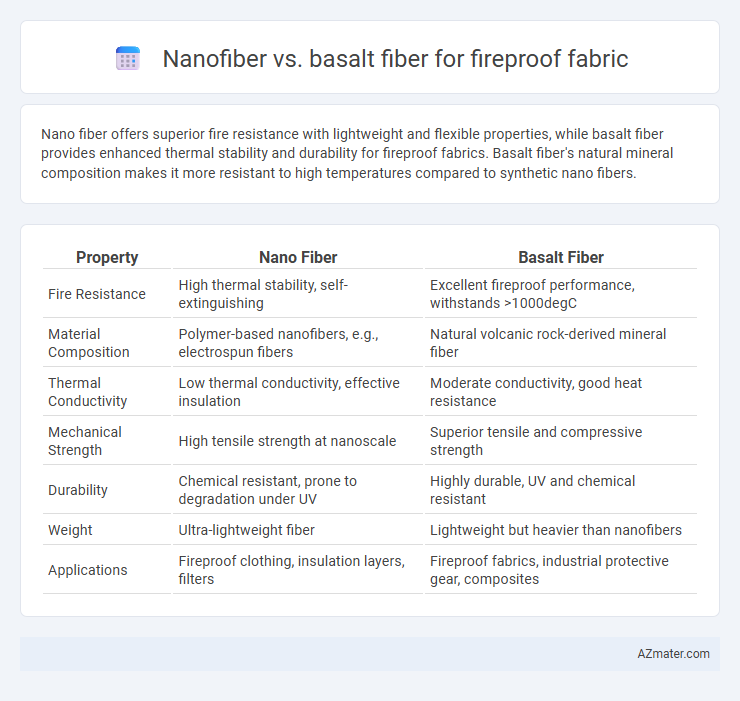Nano fiber offers superior fire resistance with lightweight and flexible properties, while basalt fiber provides enhanced thermal stability and durability for fireproof fabrics. Basalt fiber's natural mineral composition makes it more resistant to high temperatures compared to synthetic nano fibers.
Table of Comparison
| Property | Nano Fiber | Basalt Fiber |
|---|---|---|
| Fire Resistance | High thermal stability, self-extinguishing | Excellent fireproof performance, withstands >1000degC |
| Material Composition | Polymer-based nanofibers, e.g., electrospun fibers | Natural volcanic rock-derived mineral fiber |
| Thermal Conductivity | Low thermal conductivity, effective insulation | Moderate conductivity, good heat resistance |
| Mechanical Strength | High tensile strength at nanoscale | Superior tensile and compressive strength |
| Durability | Chemical resistant, prone to degradation under UV | Highly durable, UV and chemical resistant |
| Weight | Ultra-lightweight fiber | Lightweight but heavier than nanofibers |
| Applications | Fireproof clothing, insulation layers, filters | Fireproof fabrics, industrial protective gear, composites |
Introduction to Fireproof Fabrics
Fireproof fabrics are engineered materials designed to resist ignition and withstand high temperatures, offering critical protection in hazardous environments. Nanofiber and basalt fiber represent two advanced options, with nanofibers providing exceptional thermal insulation and lightweight properties due to their ultra-fine structure. Basalt fiber, derived from volcanic rock, delivers superior fire resistance, mechanical strength, and chemical stability, making it ideal for durable fireproof textile applications.
Overview of Nano Fiber Technology
Nano fiber technology involves creating ultra-fine fibers with diameters in the nanometer range, offering exceptional mechanical strength, thermal stability, and fire resistance. These fibers provide superior fireproof fabric performance by forming a dense, heat-resistant barrier that prevents flame penetration and reduces smoke generation. Compared to basalt fiber, nano fibers can deliver enhanced flexibility and lightweight properties while maintaining high durability under extreme fire exposure.
Understanding Basalt Fiber Materials
Basalt fiber, derived from volcanic basalt rock, offers exceptional thermal resistance and fireproof properties for fabric applications due to its natural composition of silicates and aluminosilicates. This material demonstrates superior stability at temperatures exceeding 900degC, outperforming many synthetic fibers in maintaining structural integrity under fire exposure. Unlike nanofibers, basalt fiber provides cost-effective durability and environmental sustainability, making it ideal for high-performance fireproof textiles in construction and protective gear industries.
Key Fire Resistance Properties
Nano fibers exhibit superior fire resistance due to their high surface area and thermal stability, enabling efficient heat insulation and reduced flame spread. Basalt fibers offer excellent fireproofing with a melting point above 1400degC and inherent resistance to chemical degradation under extreme heat. Both materials provide robust fire resistance, but basalt fibers excel in structural integrity at elevated temperatures, while nano fibers enhance barrier performance against flames.
Thermal Insulation Capabilities
Nanofiber exhibits superior thermal insulation capabilities compared to basalt fiber due to its extremely fine diameter and high surface area, which significantly reduce heat transfer through conduction and convection. Basalt fiber offers strong fire resistance with melting points exceeding 1400degC but has comparatively lower thermal insulation efficiency because of its coarser fiber structure. Nanofiber-based fireproof fabrics provide enhanced thermal barrier performance, making them more effective in applications requiring stringent heat retention and protection.
Durability and Mechanical Strength Comparison
Nano fiber exhibits superior mechanical strength with tensile strength reaching up to 5 GPa, significantly outperforming basalt fiber, which typically has tensile strength around 2.8 GPa. Durability tests reveal that nano fiber maintains structural integrity under extreme thermal conditions up to 1000degC, whereas basalt fiber begins to degrade beyond 600degC. The enhanced fireproof capabilities of nano fibers, combined with higher resistance to mechanical wear, make them more reliable for long-term fireproof fabric applications.
Flexibility and Fabric Integration
Nanofibers exhibit exceptional flexibility due to their ultrafine diameters, allowing seamless integration into fireproof fabrics without compromising elasticity or comfort. Basalt fibers offer superior thermal resistance but tend to be stiffer, which can limit fabric flexibility and reduce wearer mobility. Combining nanofibers with basalt fibers enhances fireproof fabric performance by balancing flexibility and durability for protective clothing applications.
Environmental Impact and Sustainability
Nano fiber fireproof fabrics offer superior environmental benefits due to their lightweight nature, which reduces material usage and energy consumption during production. Basalt fiber, derived from natural volcanic rock, is inherently sustainable and non-toxic, boasting excellent recyclability and a minimal carbon footprint compared to synthetic fibers. Both materials contribute to sustainable fireproof textiles, but basalt fiber stands out for its eco-friendly extraction process and biodegradability.
Cost and Commercial Availability
Nano fibers offer superior fire resistance and lightweight properties but come with higher production costs and limited commercial availability, restricting their widespread use in fireproof fabrics. Basalt fibers provide a cost-effective alternative with good thermal stability and broad commercial availability, making them a popular choice in industrial-scale fireproof textile manufacturing. The balance between nano fiber innovation and basalt fiber affordability significantly influences procurement decisions in fireproof fabric applications.
Application Suitability: Nano Fiber vs Basalt Fiber
Nano fiber offers exceptional fire resistance and thermal insulation, making it ideal for lightweight, flexible fireproof fabrics used in protective clothing and emergency blankets. Basalt fiber excels in high-temperature durability and mechanical strength, suitable for industrial fireproof applications like insulation panels and fire barriers where structural integrity is critical. Choosing between nano fiber and basalt fiber depends on whether flexibility and weight or enhanced durability and heat tolerance are prioritized in fireproof fabric applications.

Infographic: Nano fiber vs Basalt fiber for Fireproof fabric
 azmater.com
azmater.com